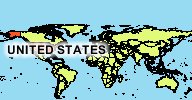 |
|
FEATURE-Costly alien invaders rock world's
balance
25 Jan 2006 01:02:00
GMT
Source: Reuters
|
By Lucas van
Grinsven
AMSTERDAM, Jan 25 (Reuters) - Blue-collar workers in Europe
and the United States who feel threatened by Asian rivals should
spare a thought for local birds, crabs and oysters, also facing
competition from more efficient eastern species.
Dull-coloured pigeons, starlings and crows used to dominate
the skies above Amsterdam, but these days citizens might spot the
brilliant green plumage of a long-tailed tropical parakeet.
Originally from Asia, 1,200 collar parakeets now live in the
Dutch capital, descendants of a small group whose owner, driven mad
by their constant chatter, set them free in the late 1970s.
The parakeets are among many species -- from Asia and
elsewhere -- that have relocated as increased world trade has
facilitated the movement of "invasive alien species".
This biological globalisation is recognised as a major threat
to biodiversity, second only to habitat destruction, and
conservationists and scientists are seeking ways to curb, or at the
very least, monitor these movements.
Annie Simpson of Global Invasive Species Information Network
(GISIN), says scientists estimate that up to 5 percent of the
world's gross domestic product is being destroyed as a result of
foreign pests and other invasive species.
The invaders can destroy habitats and drive endemic species
to extinction. In Amsterdam, woodpeckers are being driven out of
tree holes by the parakeets.
"A parakeet pushing out a woodpecker is peanuts compared with
the economic damage done by other invasive species," said Amsterdam
ecologist Remco Daalder.
Researchers have estimated the United States alone spends
$137 billion each year fighting immigrant flora and fauna, a figure
that rises to $336 billion when Britain, Australia, India, South
Africa and Brazil are included.
The World Conservation Union says uncertainty exists about
the total economic costs, but estimates of the costs of particular
species to particular sectors show a serious problem.
Environment ministers will meet in Curitiba, Brazil, from
March 20-31, for United Nations talks to protect animals and plants
from threats like pollution, global warming and invaders.
HUMANS TO BLAME
Invaders are a global problem: the Nile perch has wiped out
endemic fish in Africa's Lake Victoria; commercial fishing in the
Black Sea collapsed after the arrival of plankton-eating North
American jellyfish; and the European zebra mussel causes $5 billion
of damage a year to American industrial plants.
In most cases, humans have themselves to blame.
In the 1960s, European oyster farmers introduced Japanese
oysters to the cold North Sea after heavy frost killed off most of
the native species. The Asian shellfish started to thrive.
Driven north by the currents and without a natural enemy
because birds cannot open them, the oysters are squeezing out
mussels, colonising sandbanks, and eating the mussels' larvae.
"This has gone from an opportunity to resuscitate oyster
farming to a real threat for nature," says Hans van Geesbergen of
the Dutch mussels producers organisation.
The deregulation of national and international markets has
reduced both the barriers to trade and surveillance, causing more
invasions, said Charles Perrings at the environment department of
the University of York in Britain.
Ships transfer approximately 3 to 5 billion tonnes of
stabilising ballast water internationally each year -- one of the
main causes of globalisation of marine species.
The U.N. International Maritime Organisation (IMO) estimates
at least 7,000 different species are being carried in ballast tanks
around the world, including bacteria and other microbes.
Cholera bacteria have been discovered in ballast waters of
cargo ships and poisonous microscopic red-tide algae are absorbed by
oysters. When eaten by humans, contaminated shellfish can cause
paralysis and even death, the IMO says.
BUT CAN HUMANS SOLVE THE PROBLEM?
Once established, organisms can spread at amazing speeds.
The first Japanese crab was found in the North Sea less than
six years ago. Now they are crowding out the bigger local shore crab
and pushing north at a rate of 100 km (62 miles) per year.
"It breeds three to four times a year, compared with once a
year for the local crabs. I found a female with eggs in the middle
of winter," said Reindert Nijland, a crab specialist doing a
doctorate in molecular genetics at Groningen University.
In an attempt to tackle such a wide-ranging problem, GISIN is
drawing up a global database of invasive species.
"I think there will be a prototype global network in the next
year or so," said Michael Browne, manager of the Global Invasive
Species Database of the World Conservation Union in Auckland, New
Zealand.
"At first, it may simply integrate checklists of invasive
species from around the world so that we can see for the first time
which invasive species are where."
Building a comprehensive database of the 15,000 to 20,000
species that are known to negatively impact biodiversity from the
current online global database of 350 of the world's most common
invasive species, may take another decade.

|

| |


